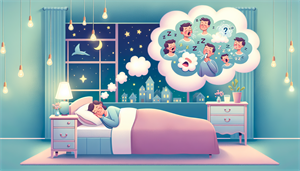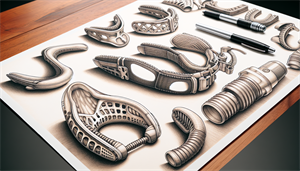Can snoring mouthpieces treat sleep apnea? Yes, for many individuals with mild to moderate obstructive sleep apnea (OSA), snoring mouthpieces can be an effective treatment.
These devices, also known as oral appliances, work by adjusting the position of the jaw or tongue to keep the airway open during sleep.
Key Takeaways
-
Snoring mouthpieces, such as Mandibular Advancement Devices (MADs) and Tongue-Retaining Devices (TRDs), can effectively treat mild to moderate obstructive sleep apnea (OSA) by repositioning the jaw or tongue to prevent airway collapse.
-
While oral appliances can improve sleep quality and reduce daytime sleepiness, they may not be suitable for severe OSA and generally require periodic replacement and maintenance for sustained effectiveness.
-
Compared to CPAP therapy, snoring mouthpieces offer a non-invasive and comfortable alternative for managing sleep apnea, though they might not deliver the same level of effectiveness in all cases.
Understanding Sleep Apnea and Snoring

Obstructive sleep apnea (OSA) involves repeated breathing interruptions during sleep due to airway blockages. Unlike central sleep apnea, where brain signaling issues are the cause, OSA results from physical obstructions such as the collapse of throat soft tissues. These interruptions, often exceeding ten seconds, cause drops in blood oxygen levels and frequent awakenings, thus severely disrupting sleep quality.
Snoring, commonly associated with OSA, can also occur without it. Loud, frequent snoring often signals OSA. Chronic snoring disrupts both the snorer’s sleep and that of anyone sharing the same sleeping environment, causing tension and sleep deprivation for both.
The consequences of untreated sleep apnea are severe and far-reaching. Frequent breathing pauses reduce blood oxygen levels, potentially leading to high blood pressure, heart disease, and other serious health issues. Those suffering from OSA often experience daytime sleepiness, fatigue, and impaired concentration, which can affect daily functioning and overall quality of life.
Oral appliances offer a sleep apnea treatment alternative for those with mild to moderate OSA, especially if CPAP therapy is intolerable. These sleep apnea oral appliances adjust the jaw or tongue position to keep the airway open, reducing snoring and enhancing sleep quality.
How Do Snoring Mouthpieces Work?
Snoring mouthpieces, or sleep apnea mouth guards, reposition the jaw or tongue to maintain an open airway, facilitating proper alignment and easier breathing during sleep.
When worn, these mouthpieces move the jaw or tongue forward, preventing throat tissue collapse. This forward positioning keeps the airway open, reducing snoring and improving airflow. Consequently, sleep quality is enhanced, and OSA symptoms are reduced.
Oral appliance therapy, including snoring mouthpieces, is increasingly popular as a non-invasive, easy-to-use alternative to CPAP machines.
Devices like mandibular advancement devices (MADs) and tongue-retaining devices (TRDs) provide practical solutions for managing sleep apnea without bulky equipment.
Types of Snoring Mouthpieces for Sleep Apnea
There are two main types of snoring mouthpieces used for treating sleep apnea: Mandibular Advancement Devices (MADs) and Tongue-Retaining Devices (TRDs). Each type has its unique method of functioning and suitability depending on individual needs and preferences.
Mandibular Advancement Devices (MADs)
Mandibular advancement device (MADs) move the lower jaw forward to reduce airway obstruction. Covering the upper and lower teeth, these devices push the lower jaw forward to keep the airway open, effectively reducing snoring and improving breathing.
MADs are available in various designs, including one-piece and two-piece configurations, with the latter allowing more jaw movement and greater comfort. Customization by a dentist significantly enhances their effectiveness and comfort compared to off-the-shelf versions. Prices can range from under $100 for simple models to several thousand dollars for custom ones.
The goal of using a MAD is to move the lower jaw forward to open the airway, improving sleep quality and reducing OSA symptoms. Custom-fitted MADs are generally more comfortable and effective, making them a preferred choice for many patients.
Tongue-Retaining Devices (TRDs)
Tongue-Retaining Devices (TRDs) hold the tongue forward to prevent airway collapse. Using suction to keep the tongue from falling back into the throat, these dental devices maintain an open airway, benefiting those who lack sufficient dental support for a MAD.
Though less commonly prescribed than MADs, TRDs can be effective for certain patients. The suction-based mechanism stabilizes the tongue, reducing snoring and improving breathing. TRDs are a viable alternative for those unable to use MADs due to dental issues or personal preference.
Effectiveness of Snoring Mouthpieces in Treating Sleep Apnea

Studies indicate that snoring mouthpieces can significantly improve airway patency by repositioning throat soft tissues. A mid-frequency anti-snoring device, for example, effectively reduced the apnea-hypopnea index and improved oxygen saturation in patients with moderate OSA, while also expanding the oropharyngeal airway.
Patients using snoring mouthpieces often report significant improvements in quality of life and decreased daytime sleepiness. Consistent use is crucial for effectively treating OSA. However, while effective, oral appliances may not match the effectiveness of CPAP therapy, particularly for severe OSA cases.
Custom-fitted mouth guards are generally more effective than premade versions as they fit the individual’s mouth structure. TRDs can reduce breathing pauses and improve blood oxygen levels, effectively decreasing daytime sleepiness. Despite these benefits, CPAP therapy completely treats nearly twice as many patients compared to oral appliances.
Benefits of Using Snoring Mouthpieces

Snoring mouthpieces can improve sleep quality and overall breathing. Generally more manageable and used more regularly than CPAP machines, they are an attractive option for many. For those with mild to moderate sleep apnea, these devices offer significant advantages in condition management.
Custom mouth guards, designed to fit an individual’s unique mouth structure, generally provide greater efficacy in treating sleep apnea. By preventing airway obstruction and reducing snoring, these devices contribute to better sleep and improved daytime functioning.
The benefits of using sleep apnea mouth guards depend on factors such as the type of device and whether it is customized to fit the user.
Potential Drawbacks of Snoring Mouthpieces

Despite their benefits, snoring mouthpieces can have drawbacks. They may lead to drooling and tooth discomfort, and some users may experience TMJ dysfunction or pain from continued use. Side effects may persist and evolve, necessitating adjustments and follow-up care.
A long-term issue with sleep apnea mouth guards is progressive tooth movement. The nightly use of these devices increases the likelihood of dental changes. Teeth shifting can occur after prolonged use, necessitating regular replacements to maintain effectiveness.
Sleep apnea mouth guards are typically effective for only a year or two, requiring periodic replacement to ensure continued efficacy. Regular replacements and adjustments add to the overall cost and maintenance requirements of the sleep apnea mouth guard.
When Snoring Mouthpieces May Not Be Suitable
Snoring mouthpieces may not be effective in certain situations and patient conditions. For example, children with breathing problems may not benefit from these devices. Oral appliance therapy is generally unsuitable for severe OSA cases, where alternatives like CPAP therapy may be necessary.
Oral appliance therapy is most effective for those with mild to moderate OSA who cannot tolerate CPAP. Additionally, if sleep apnea stems from conditions like tongue-tie, alternative treatment plans are necessary instead of a mouthpiece.
Getting a Custom Snoring Mouthpiece
Obtaining a custom mouthpiece usually begins with a consultation with a healthcare provider. A diagnosis of OSA is required for a customized mouthpiece. Once diagnosed, a dental impression is taken to create a custom-fitted device.
The teeth impression is sent to a laboratory for final mouthpiece fabrication. Custom mouthpieces are designed to fit an individual’s unique mouth structure, providing superior results for treating OSA. Periodic dental checkups are essential to ensure the mouthpiece remains effective and properly fitted.
Custom-made mouthpieces, crafted from a plastic-like mold, offer a better fit and greater comfort than premade versions. By addressing the underlying structural factors of OSA, these devices can significantly improve sleep quality and reduce symptoms.
Maintaining Your Snoring Mouthpiece
Maintaining proper cleaning and storage practices is crucial for keeping your mouthpiece effective. Rinse it with warm water after each use and gently brush with a soft toothbrush. Perform a deep cleaning weekly by soaking the mouthpiece in mild dish soap or denture cleaner for 15-20 minutes.
Avoid abrasive toothpaste or harsh chemicals as they can damage the mouthpiece. Let it air dry completely to prevent bacteria growth and store it in a clean, dry, ventilated case.
Regularly clean the storage case to prevent bacteria buildup and ensure the longevity of your mouthpiece.
Follow-Up Care and Adjustments
Follow-up appointments are essential for monitoring adaptation to the mouthpiece and ensuring its long-term effectiveness. Regular evaluations address any discomfort or complications from prolonged use. Dentists may adjust the device to optimize effectiveness and comfort based on patient feedback.
Follow-up monitoring helps gauge improvements in sleep quality and overall health. Dentists can recommend additional sleep studies if necessary to reassess the severity of sleep apnea after using the mouthpiece.
This comprehensive approach ensures effective treatment and long-term sleep health.
Comparing Snoring Mouthpieces to CPAP Therapy

CPAP therapy, or continuous positive airway pressure therapy, is often considered the most effective treatment for improving airflow in sleep apnea patients. However, oral appliance therapy, including snoring mouthpieces, is becoming a popular alternative for those unable to use a cpap machine. Oral appliances are preferred for their comfort and convenience, especially for travel.
Studies indicate that MADs are effective for reducing breathing pauses, although not as effective as CPAP in improving blood oxygen levels. Nonetheless, they perform similarly in reducing daytime sleepiness, snoring, and blood pressure. Mouth guard users may use them one more night per week and nearly two hours longer per night compared to CPAP users.
For severe sleep apnea patients who cannot tolerate CPAP, dental appliances provide a viable alternative. Some patients use oral appliances along with CPAP therapy to reduce the amount of pressurized air received, offering a balanced approach to treating sleep apnea.
Summary
Snoring mouthpieces offer a promising solution for managing sleep apnea and snoring, particularly for those with mild to moderate conditions. By adjusting the position of the jaw or tongue, these devices can significantly improve sleep quality and reduce symptoms. However, they are not without potential drawbacks and may not be suitable for everyone.
Ultimately, the choice between snoring mouthpieces and CPAP therapy depends on individual needs and preferences. Consulting with a sleep specialist and undergoing a thorough evaluation is essential to determine the best treatment option. By taking proactive steps to address sleep apnea, you can improve your sleep health and overall quality of life.
Frequently Asked Questions
Can snoring mouthpieces treat severe sleep apnea?
Snoring mouthpieces are not typically effective for severe sleep apnea; instead, CPAP therapy is recommended for those cases. It's important to consult a healthcare professional for appropriate treatment options.
How do mandibular advancement devices (MADs) work?
Mandibular advancement devices (MADs) effectively work by repositioning the lower jaw forward, which reduces airway obstruction and enhances breathing during sleep. This mechanical adjustment significantly improves sleep quality for those suffering from obstructive sleep apnea.
Are custom-fitted mouthpieces better than premade ones?
Custom-fitted mouthpieces are indeed better than premade ones, as they provide a tailored fit that enhances comfort and effectiveness. A personalized design can lead to improved performance and satisfaction.
What are the potential side effects of using a snoring mouthpiece?
Using a snoring mouthpiece can lead to side effects such as drooling, tooth discomfort, and TMJ dysfunction, along with the possibility of progressive tooth movement. It’s important to discuss these risks with your healthcare provider before use.
How often should I replace my snoring mouthpiece?
You should replace your snoring mouthpiece every one to two years to ensure its effectiveness. Regular maintenance is key for optimal performance.


